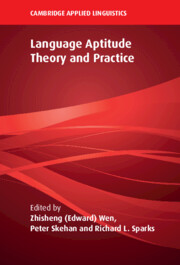Book contents
- Language Aptitude Theory and Practice
- The Cambridge Applied Linguistics Series
- Language Aptitude Theory and Practice
- Copyright page
- Contents
- Figures
- Tables
- Editors and Contributors
- Preface and Acknowledgments
- 1 Language Aptitude Research
- Part I Revisiting and Refining Aptitude Tests
- Part II Aptitude Testing of Diverse Groups
- 6 Testing Language Aptitude for Chinese Learners of Foreign Languages
- 7 Testing Language Aptitude for Recently Arrived Parent–Child Immigrant Dyads
- 8 Is Language Aptitude Immune to Experience?
- 9 Testing Language Aptitude
- Part III Innovative Perspectives and Paradigms
- Part IV Aptitude–Treatment Interaction (ATI)
- Part V Final Commentaries
- Index
- References
9 - Testing Language Aptitude
A Commentary on Batteries and Reanalysis of Constructs
from Part II - Aptitude Testing of Diverse Groups
Published online by Cambridge University Press: 27 May 2023
- Language Aptitude Theory and Practice
- The Cambridge Applied Linguistics Series
- Language Aptitude Theory and Practice
- Copyright page
- Contents
- Figures
- Tables
- Editors and Contributors
- Preface and Acknowledgments
- 1 Language Aptitude Research
- Part I Revisiting and Refining Aptitude Tests
- Part II Aptitude Testing of Diverse Groups
- 6 Testing Language Aptitude for Chinese Learners of Foreign Languages
- 7 Testing Language Aptitude for Recently Arrived Parent–Child Immigrant Dyads
- 8 Is Language Aptitude Immune to Experience?
- 9 Testing Language Aptitude
- Part III Innovative Perspectives and Paradigms
- Part IV Aptitude–Treatment Interaction (ATI)
- Part V Final Commentaries
- Index
- References
Summary
The present chapter has two general aims. The first is to survey the range of aptitude batteries and sub-tests that are discussed in the literature, and then to explore how they relate to one another and what emphases each of them contains. To achieve this, the various sub-tests will be located in terms of two dimensions: whether they are domain-specific or domain-general, and whether they require implicit or explicit processes and learning. In addition, how the different domains of sound, working memory, processing, language and learning are handled in each of the sub-tests will be explored. The second aim is to explore what insights aptitude tests might contribute to theorizing about the nature of second language learning. The different theoretical accounts will be examined, and then existing aptitude tests will be related to them, indicating clear coverage in some areas, and not very much in others. Overall, it is argued that aptitude work, viewed in this way, should be central to second language acquisition and reveal how we can understand and predict it.
Keywords
- Type
- Chapter
- Information
- Language Aptitude Theory and Practice , pp. 208 - 246Publisher: Cambridge University PressPrint publication year: 2023
References
- 1
- Cited by

